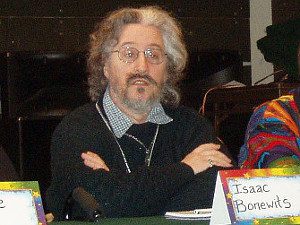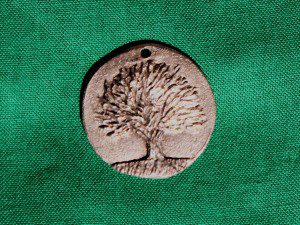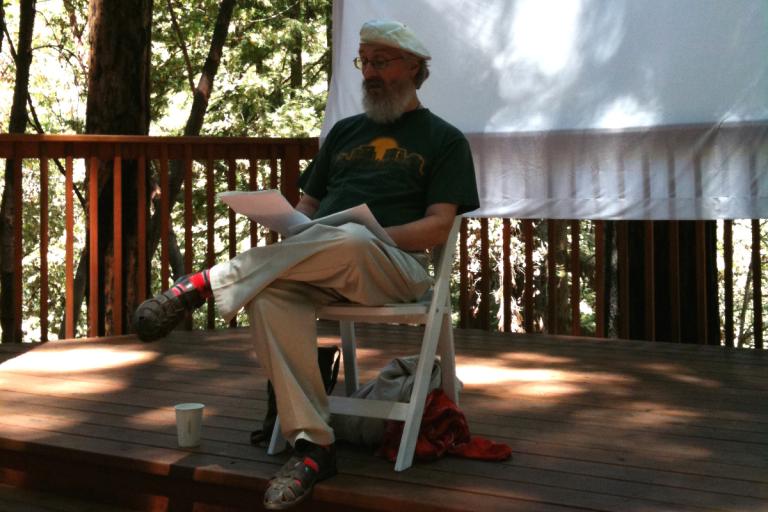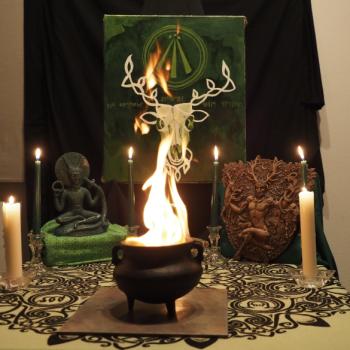
The list of people who have influenced my Paganism is long and I am thankful for all of them. But there is one person at the top of that list: Isaac Bonewits.
Isaac died from cancer in 2010 at the too-young age of 60. I wrote about my two experiences of meeting him in person as a eulogy. ADF has a biographical eulogy by Ian Corrigan. And Isaac’s website is still up and still has much of his work available – it’s been maintained by his widow Phaedra, who is a skilled magician in her own right and a former Vice President of CUUPS Continental. If you aren’t familiar with Isaac and his work (where have you been?!) these are good places to start.
In this post, I want to talk about how Isaac influenced my early Pagan journey, and why he remains a big influence today.
Scholarship matters. I think I first encountered Isaac in Drawing Down the Moon (published in 1979). Margot Adler quoted him liberally in her review of Wicca and its links (or lack thereof) to ancient paganism and witchcraft.
As someone who was coming out of a religion where I was told I had to believe myths were literal truth, it was important for me to build my new religion on a firm foundation that separated the two. The works of Robert Graves and Margaret Murray have been inspirational to many, but inspiration is no substitute for the work of historians, archaeologists, anthropologists, and literary scholars.
Paleopagan, Mesopagan, Neopagan. The lineage from the ancients to today is neither as continuous nor as broken as many on both sides have claimed. But when I was getting started, it was very helpful to have Isaac separate indigenous practices (Paleopagans), revivals of those practices influenced by the Christian culture of their times (Mesopagans), and the re-creations of ancient practices for contemporary times (Neopagans).

When I first read Wiccan books that talked about archangels, watchtowers, and the Tree of Life, I knew they weren’t talking things my ancient Celtic ancestors ever did. That’s one of the reasons Wicca never worked for me – I wanted a clean break from the Abrahamic religions. Druidry provides a connection to my ancient ancestors, though even here the Druid Revival is full of Mesopagans. I honor them as my spiritual ancestors and I am inspired by their work, but my Druidry is based on Isaac’s vision of Neopaganism.
Today the term Neopagan has lost much of its meaning. Some would say the polytheist movement is the next step beyond Neopaganism. Others would say it’s a purer form of Neopaganism. I’m not interested in arguing over the name. I just want to do the best I can to re-create and re-imagine ancient practices that are meaningful and helpful here and now.
“Why not excellence?” The Pagan movement (especially in the United States) has long emphasized the equality of all. But while Isaac made it clear that racism, sexism, homophobia, and other prejudice has no place in Paganism, he also understood that different people have different skills, interests, and abilities. In his vision for ADF, he said “we didn’t expect everyone in ADF to be qualified for (or even interested in) attaining the rank of clergy.” Hierarchy isn’t inherently bad – it’s only bad when it’s abused.
“Why not excellence?” remains ADF’s motto.
The Laws of Magic. Isaac’s book Real Magic was published in 1971, a time when many assumed the workings of witches and psychics would be explained by science in just a few years. It hasn’t worked out that way, for reasons that have as much to do with the assumptions of science as the nature of magic.
Isaac’s Laws of Magic were written as a guide for early fantasy role playing games. But the best games are good because they’re based in reality, and Isaac’s laws remain the best description of how and why real magic works.
“Fuzzy targets yield fuzzy results.” Practice magic more than once or twice and it quickly becomes apparent that while seemingly-ordinary people can do extraordinary things, our abilities and capacities are limited. So the more narrowly we focus our efforts the greater chance we have of making an impact. This is why magical workings to “save the planet” accomplish nothing, while workings to preserve the habitat of a specific species in a specific location can often be effective.
Beyond that, if you can’t describe what you want, what you get may be something very different from what you have in mind. “World peace” is a nice thought, but it means something very different to a fascist than it does to a communitarian.
Keep your spells focused on narrowly defined targets at the lowest level possible.
“It don’t mean a thing if it ain’t got that swing.” Isaac’s book Neopagan Rites is simply the best how-to book for planning and presenting public rituals in existence today. Its subtitle is A Guide to Creating Public Rituals that Work. My own preferred liturgy draws heavily from Isaac’s work, as (of course) does the core order of ritual of ADF.
But while a good liturgy is essential to good ritual, if it’s presented without passion it’s still going to fall flat. Good ritual speaks to all your senses: you don’t just hear people talk, you smell the incense, you taste the wine, you feel the Earth, and perhaps most importantly, you see the ritual performed. This is why we wear robes and jewelry, cover unused furniture, decorate altars, and light a million candles. And why we use music and drumming as well as spoken words.
Good ritual doesn’t just speak to your head – it speaks to your whole body… and it speaks to your soul.
“Enthusiasm is no substitute for competence.” You want your rituals to have swing, but if they aren’t planned and presented competently they won’t accomplish much. “Spontaneity” isn’t quite the buzzword it was in Pagan circles a few years ago, and that’s a good thing. When you’re by yourself, going outside and standing under the full moon waiting for the Gods and spirits to speak to you can be a powerful experience. When you’ve got 15 or 20 or 50 people standing in a circle wondering why they came here on a perfectly good Saturday night, it can be a recipe for disaster.
I will never forget watching Isaac and Phaedra leading the main ritual at the 2004 CUUPS Convocation. I was still fairly new to public Paganism. I had seen a few good rituals and a few bad ones… and I had led a couple of each. When I watched them work, I saw how good ritual could be if the leaders were both enthusiastic and competent.
I can’t do what Isaac did – I don’t have his charisma. Few do. But I’ve learned how to combine good composition and the liturgical skills I do have with a ton of practice to do a good job of facilitating religious experiences in ritual.
Isaac Bonewits was a unique individual in a religious movement full of individuality. I’m glad I got to meet him and participate in ritual with him. I’m glad he founded a religious order to build his vision of Paganism – and I’m glad to be a member of it. And I’m so thankful we have his books to preserve his ideas for future generations.
I learned a lot from Isaac Bonewits. Future generations of Pagans will too.


















